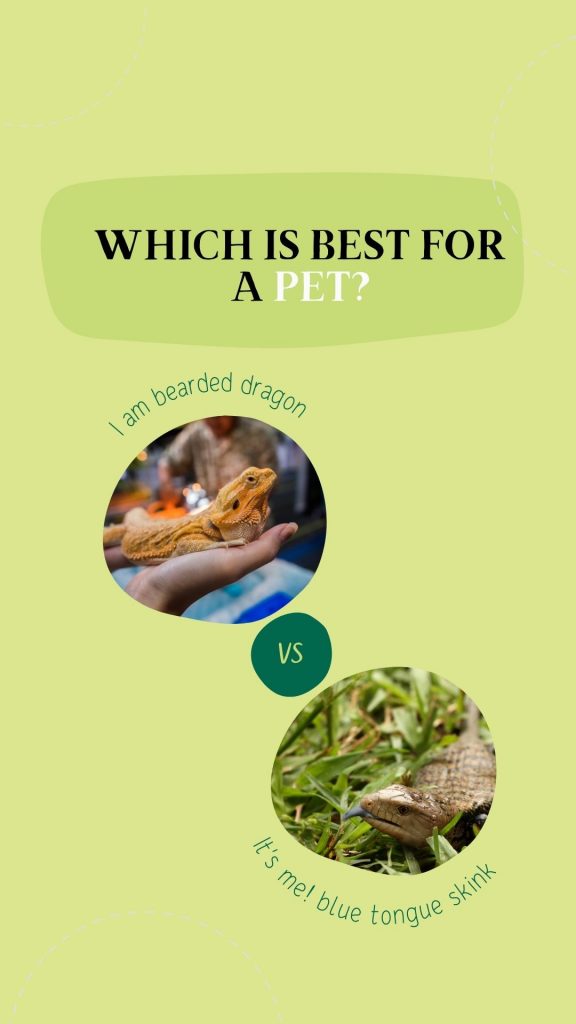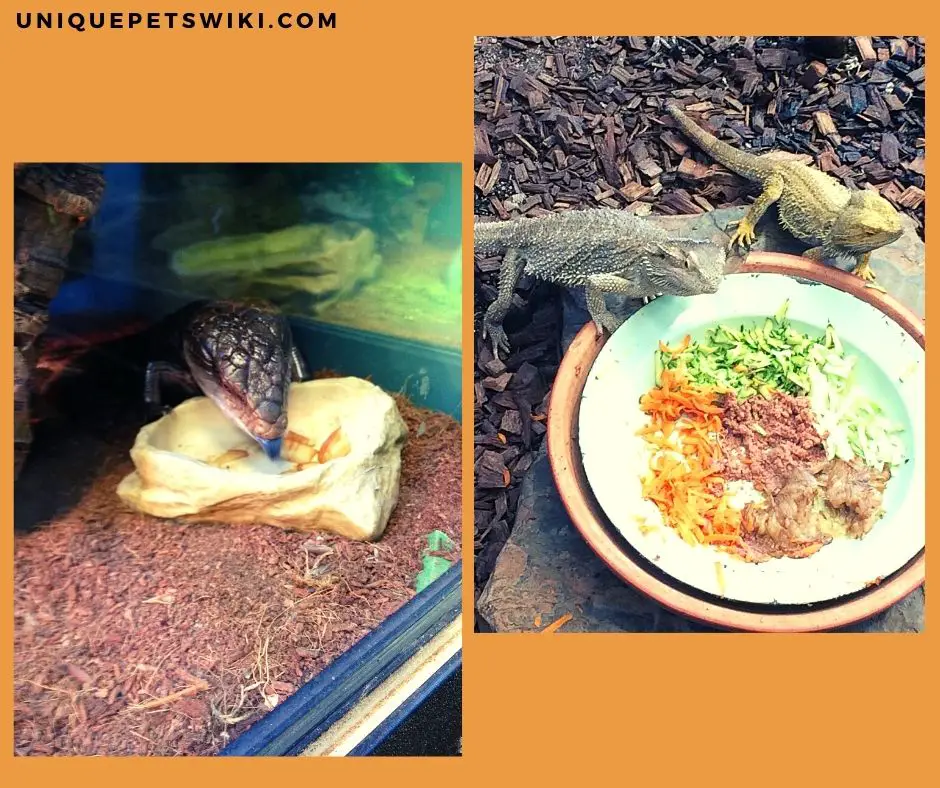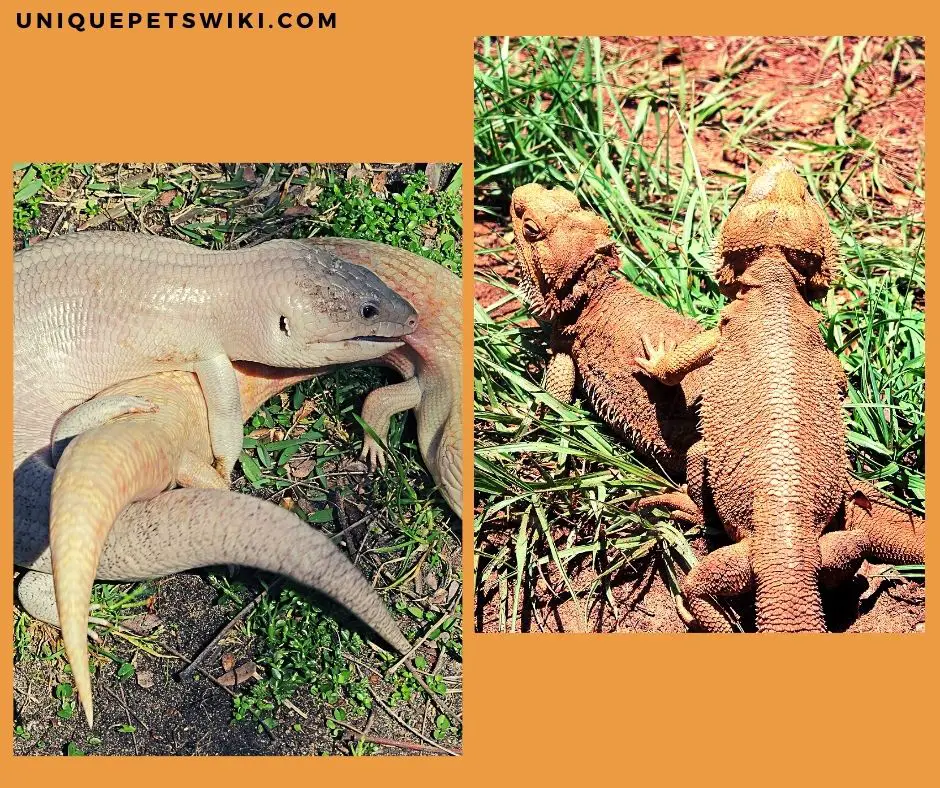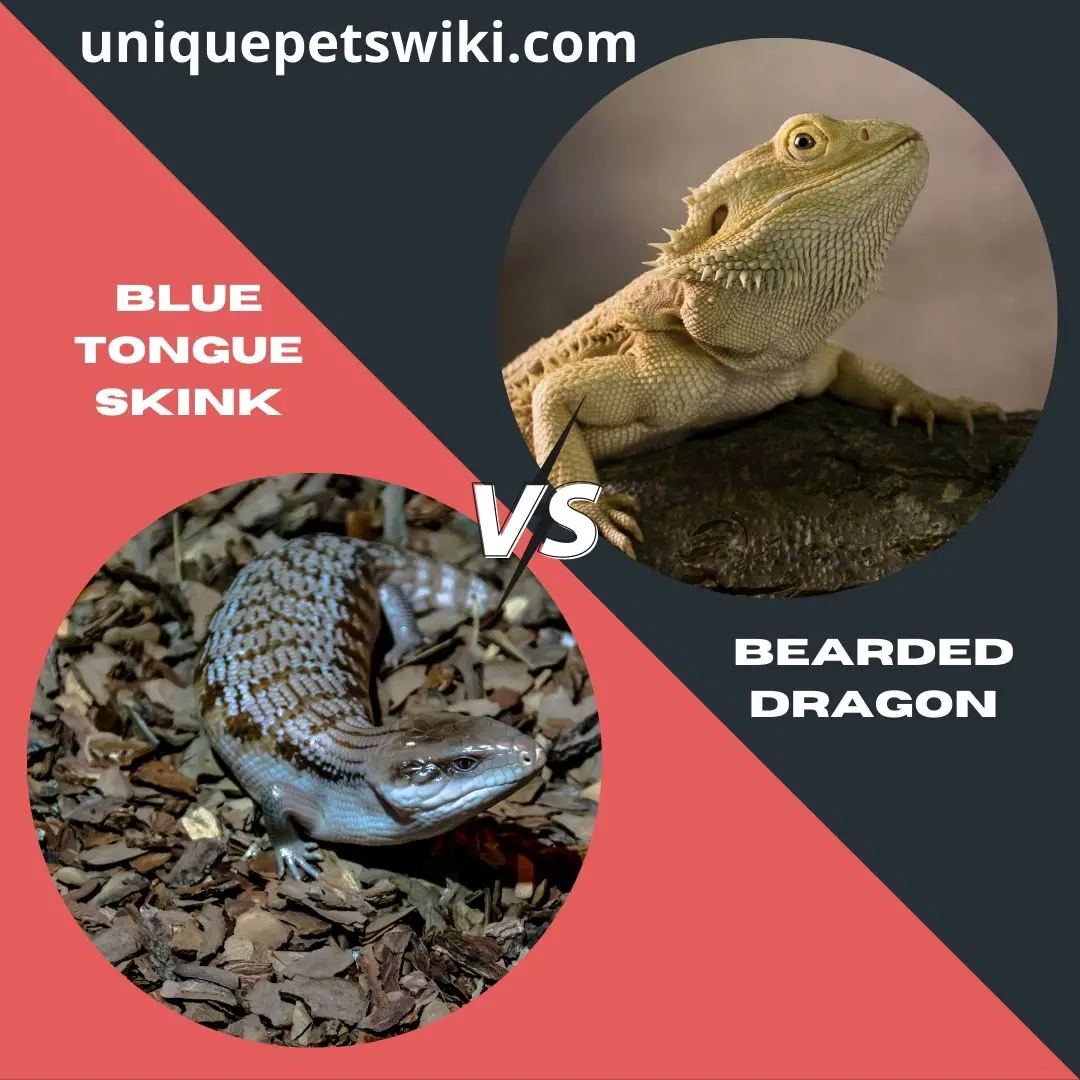Bluetongue skink and bearded dragons are unanimously intelligent, friendly, and pleasant buddies as far as lizards are concerned. Deciding to choose one pet between a blue tongue skink and a bearded dragon is a task on its own.
It may seem easy, especially when hearing people commending the two lizards, but wait until you have to make the decision.
That’s when you know judging by physical appearance is never enough and isn’t a reliable way to help you get a befitting pet for you.
You need a lot more knowledge about each species to decide the one that best suits your desires. This article gives a comprehensive comparison of blue tongue skinks and bearded dragons as pets. Read through for more!
Contents
Blue Tongue Skink Vs Bearded Dragon: Full Comparison
Blue Tongue skinks are different from bearded dragons in many aspects, including appearance, temperament, socialization, delights, etc.
However, there are still some characteristics common to both lizards. For instance, they all have a docile nature and are affectionate. However, their differences transcend the similarities.
Both blue tongue skinks and bearded dragons are extraordinary pets and knowing the pet you need depends on your life’s goal with it. For example, bearded dragons are champions in climbing, while blue tongue skinks are clumsy climbers.
So, a bearded dragon would be suitable if you want a pet that climbs on you and relaxes at your shoulder.
We will major on other features or characteristics of each lizard and see how the two species differ or resemble each other. Get a load of the following features!
Physical Description About Species
Blue Tongue skinks closely resemble snakes in the texture of their skin and a little bit of body conformation. Skinks are beautiful lizards with striking colors and patterns, depending on morphs.
Their skin color can vary from jet black, orange, tan, white, gold, and yellow, and perhaps with a combination of striking patterns. The thing that makes these reptile lizards magnificent is their blue tongue.
Oppositely, bearded dragons have abundant spikes under their throat and some loaded at the edges of the body.
The spikes appear pretty sharp, but they are rubbery and will never hurt anyone. Bearded dragons also come in diversified morphs with noticeable colors.
Conclusion: Blue Tongue skinks have smooth and scaly skin, while bearded dragons’ bodies are loaded with rubbery spikes and scales.

Size, Weight, and Lifespan
Typically, blue tongue skinks have an average life expectancy of approximately 15-20 years. Although it’s uncommon, a few species can exceed the range and grow as old as 25 years under extreme care.
Conversely, bearded dragons are known to live anywhere from 8-12 years and some will barely reach the range under poor care. Fortunately, some beardies will even live for up to 15-20 years with maximum care, but it’s uncommon too.
In terms of size and weight, mature blue tongue skins usually reach 18-24 inches long and weigh 250-600g, but some species can go as high as 800g.
The average length of bearded dragons is 16-24 inches and typically weighs 250-500g, except the giant species that goes up to 1000g.
Conclusion: Blue Tongue skinks have an increased lifespan than bearded dragons, but both lizards are almost similar in size and weight.
Range And Habitat
Blue Tongue skinks are inhabitants of grasslands, woodlands, scrublands, coastal heaths, gardens, backyards, forests, and semi-desert areas.
These reptile lizards predominantly occur across most parts of Australia and the Tanibar islands of Indonesia. They originate from the deserts of Australia and demand staying under high temperatures
Bearded dragons exist in-band across much of Australia and usually prefer to stick to temperate, subtropical, semi-arid woodlands, scrublands, savannas, rocky areas, and hummock grasslands.
Conclusion: Both the skinks and beardies are ectothermic and thrive well under optimal temperatures.
Active Level
Blue Tongue skinks are diurnal reptile lizards, meaning they’re active during the day and sleep during the night.
Blue Tongue skinks are superb burrowers, and their main task during the day is burrowing and clambering over rocks and logs.
Bearded dragons are also sleeping at night and get pretty busy during the day. They are diurnal creatures.
They are semi-arboreal reptile lizards that love climbing on branches, logs, posts, rocks, broken trees, and so forth.
Conclusion: Blue Tongue skinks and beardies are diurnal reptiles with many activities to do in the daytime.
Personality
Blue Tongue skinks are tameable and exceedingly friendly. However, how amiable a skink is, varies depending on species, with the friendliest lizards being the Northern, Jaya, Irian, Blotched, shingle backs, and Merauke.
Most skinks are curious, and they greatly enjoy being outside the tank, exploring and interacting with their owners.
Bearded dragons are intelligent, friendly, docile, and tolerate handling. Being handled by their owners is something they treasure.
They cherish being outside the tank, exploring, climbing, sitting on the owner’s shoulder, and playing with them.
Conclusion: The skinks and bearded dragons are tameable, intelligent, playful, superb explorers, friendly, and great for handling. Bluetongue skins essentially remember their owners, but the beardies are seen even interacting with strangers.
Defense Mechanism
Blue Tongue skinks‘ tongue has a significant importance when it comes to threatening predators. When approached by predators, the skinks puff up and flatten out their bodies to appear as large as they can.
Subsequently, they hiss loudly, open the mouth wide, and level out the blue tongue. Another tactic of defense that skinks use is dropping tail and biting
On the other hand, bearded dragons have defense tactics to scare off animals that can turn them into a meal. They puff up their beard to look huge and scary.
Conclusion: The beardies don’t drop their tail like the skinks. Both lizards typically use scare tactics to frighten predators. They can also bite predators that get too close to them.
Diet
Blue Tongue skinks typically eat insect proteins and vegetation. The top list protein foods for the skinks are live bugs, snails, dog food, lean meat, and rarely some cooked eggs.
Guava, watermelon, blueberries, apples, carrots, broccoli, white mushroom, etc., have a substantial impact on a blue tongue skink diet.
Bearded dragons are also omnivorous reptile lizards. Their diet entails insects, fruits, vegetables, and greens. The baby beardies mainly eat protein foods, but adults have a high demand for vegetation.
Conclusion: Bearded dragons require a lot of insect protein when young but primarily consume plant matter as they age. Blue Tongue skinks eat a diversity of foods. Both lizards eat more when young and are more petite after maturing.

Brumation
Blue Tongue skinks tend to brumate during cold weather and winter. Their brumation is short, mostly lasting for a month, but some species will brumate as long as 2-4 months.
Likewise, some species of bearded dragons go into brumation during the colder months of the year. They usually brumate for 2-3 months.
Conclusion: Both bearded dragons are blue tongue skinks that tend to brumate during winter. They are mostly resting and sleeping during this period, and this helps to conserve their energy.
Breeding
Blue Tongue skinks are viviparous. The females gestate for 100 days and give birth to live young.
In most cases, females are unwilling to mate, which costs the males a lot of time to convince them to breed. The males continuously follow the females before the former give in to the game.
The male skinks are sexually mature at 12 months old, while females should only mate when around 24 months of age. After gestation, a female skink can produce anywhere from 4-15 babies.
Bearded dragons produce fertile eggs after mating. But they can also lay infertile eggs without breeding. They lay their eggs in clutches and generally produce 2-5 clutches per breeding season.
Each clutch consists of 20-40 eggs or even more. The female beardies are safe mating when they’re 24 months old, but males can breed at 18 months of age.
Conclusion: Blue Tongue skinks are viviparous, while bearded dragons are oviparous. The female skinks are hard to breed since they can reject the male. Moreover, the skinks have fewer babies than bearded dragons in a single breeding season.

Required Take Care
If you look forward to raising a happy and healthy pet, always consider providing a suitable habitat.
All exotic pets, including the captivated bearded dragons and blue tongue skinks, are required to live the way they would live in their natural habitat. The home you provide should mimic everything in their natural home.
Enclosure Size
Blue Tongue skinks can stay in a 40-gallon tank, but the space is limited and cannot accommodate the lizard and accessories. The most recommended enclosure size for the adult skinks is 55-65-gallon.
The adult bearded dragons are perfectly fine in a 55-65-gallon tank or more. The tank should be wide horizontally and have a convenient height for moderate climbing.
Conclusion: Blue Tongue skinks and the beardies are almost the same in size. They require a similar enclosure size of about 55+gallons to thrive and be happy.
Lighting, Heating, and Humidity Requirements
Blue Tongue skinks are desert inhabitants and therefore require high temperatures to thrive. Their basking spot should range from 90-100℉. Ideal temperatures in the cool spot range from 75-80°F.
These lizards need to be under 10-12% UVB tube light and bright light at daytime for appropriate heat. The ideal humidity level of skinks ranges from 30-40%, but some species like Irian require a much higher level.
Bearded dragons are also desert animals and have high-temperature demands. The temp in their basking spot should go as high as 90-110℉ and a cool site of 75-85℉.
The beardies humidity level should reach 35-40% and require a high output of UVB tube light of 10-12%.
Conclusion: Both species need to stay under high temperatures and light during the day. They require a high output UVB light bulb.
Suitability: Best for Whom?
Blue Tongue skinks have an extensive list of edible foods, and they don’t eat so much. Likewise, these reptile lizards are hardy and friendly, hence qualifying them to be suitable for beginners.
The main thing that you have to pay attention to is heat, UVB, and humidity. Consider also giving a healthy and balanced diet.
Bearded dragons are another pet that beginners will raise without problems. They are friendly, hardy, affectionate, and easy to handle.
However, baby bearded dragons are relatively expensive because of their high requirement for abundant and live feeder bugs.
Conclusion: Blue Tongue skinks and beardies are suitable lizards for beginners, except bearded dragons are slightly expensive to maintain because they’ll eat a little more.
Costs
Blue tongue skinks are relatively expensive and typically cost between $150-$250, depending on the species. The food for blue tongue skinks can cost around $20-$30, depending on what you’re feeding.
Electricity bills will fall anywhere from $5-$10 per month. Note that you will need to replace their UVB light tube bulb after every six months.
On the other hand, If you need a bearded dragon, you will buy one anywhere from $60-$100. Bearded dragons require a slightly high budget for electricity and food.
They eat more food than the skinks. The babies are expensive to raise; for instance, it can cost around $20-$40 to buy their food per week.
For the adults, you will spend $20-$40 per month on food costs. Moreover, you should change their UVB lights every six months.
Conclusion: Bearded dragons are only expensive to maintain when young but become cheaper with age. The overall cost of raising bearded dragons and blue tongue skinks is almost the same but the latter are expensive to purchase.
Ability To Keep in Groups
Blue Tongue skinks will often become aggressive towards other cage mates and engage in a fight. Housing them separately is recommended.
However, some species like shingleback, blotched, and eastern skinks can tolerate each other, but only males vs. females. If you house them together, please be sure to provide a large setup.
Bearded dragons are aggressive towards each other most of the time. They are highly territorial and become more comfortable and happier when living alone.
Conclusion: Bearded dragons always need to live alone, while some blue tongue skinks species can comfortably share a terrarium.
Can You Keep Blue Tongue Skink and Bearded Dragon Together?
Bearded dragons and blue tongue skinks are happy when living singly. The skinks are quickly offended by cage mates, and bearded dragons are pretty territorial.
Housing these two lizards in one cage will make them feel uncomfortable; plus, they could seriously hurt each other.
Furthermore, the heating, lighting, and humidity needs for these two reptile lizards are not precisely the same. Meaning as you try to make one lizard comfortable, the other one will be hurt.
You can never meet their needs when they’re both in one enclosure. Therefore, you cannot keep a blue tongue skink and a bearded dragon together and expect them to thrive. They are pretty different species with different requirements.
Conclusion
Blue Tongue skinks and bearded dragons make wonderful reptile pet lizards. Each species has its outstanding characteristics that make them unique and captivating pets.
Some people will love blue tongue skinks for a specific reason, and some have a heart for bearded dragons.
Hopefully, you will have an easy time deciding whether to pick a blue tongue skink or bearded dragon after reading this article.
